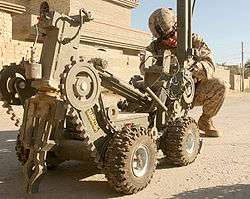Teleoperation
Teleoperation (or remote operation) indicates operation of a system or machine at a distance. It is similar in meaning to the phrase "remote control" but is usually encountered in research, academic and technical environments. It is most commonly associated with robotics and mobile robots but can be applied to a whole range of circumstances in which a device or machine is operated by a person from a distance.

The term teleoperation is in use in research and technical communities as a standard term for referring to operation at a distance. This is as opposed to telepresence which is a less standard term and might refer to a whole range of existence or interaction that include a remote connotation.
History
The 19th century saw many inventors working on remotely operated weapons (torpedoes) including prototypes built by John Louis Lay (1872), John Ericsson (1873), Victor von Scheliha (1873), and the first practical wire guided torpedo, the Brennan torpedo, patented by Louis Brennan in 1877.[1][2] In 1898, Nikola Tesla demonstrated a remotely controlled boat with a patented wireless radio guidance system that he tried to market to the United States military, but was turned down.[3]
Teleoperation is now moving into the hobby industry with first-person view (FPV) equipment. FPV equipment mounted on hobby cars, planes and helicopters give a TV-style transmission back to the operator, extending the range of the vehicle to greater than line-of-sight range.
Examples
There are several particular types of systems that are often controlled remotely:
- Entertainment systems (i.e. televisions, VCRs, DVD players etc.) are often controlled remotely via a remote control.
- Industrial machinery is often operated remotely, particularly in hazardous environments. One notable example is in the construction of the Object Shelter or sarcophagus at Chernobyl after the Chernobyl accident.
- Remotely operated vehicles (ROVs) are extensively used in hazardous environments (i.e. radioactive environments, contaminated environments, minefields, deep oceans).
- Remote surgery
- Unmanned aerial vehicles, also known as drones
References
- Gray, Edwyn (2004). Nineteenth-century Torpedoes and Their Inventors. Annapolis, Maryland: Naval Institute Press
- Roger Branfill-Cook, Torpedo: The Complete History of the World's Most Revolutionary Naval Weapon, Naval Institute Press, 2014, page 45
- Roger Branfill-Cook, Torpedo: The Complete History of the World's Most Revolutionary Naval Weapon, Naval Institute Press, 2014, page 31